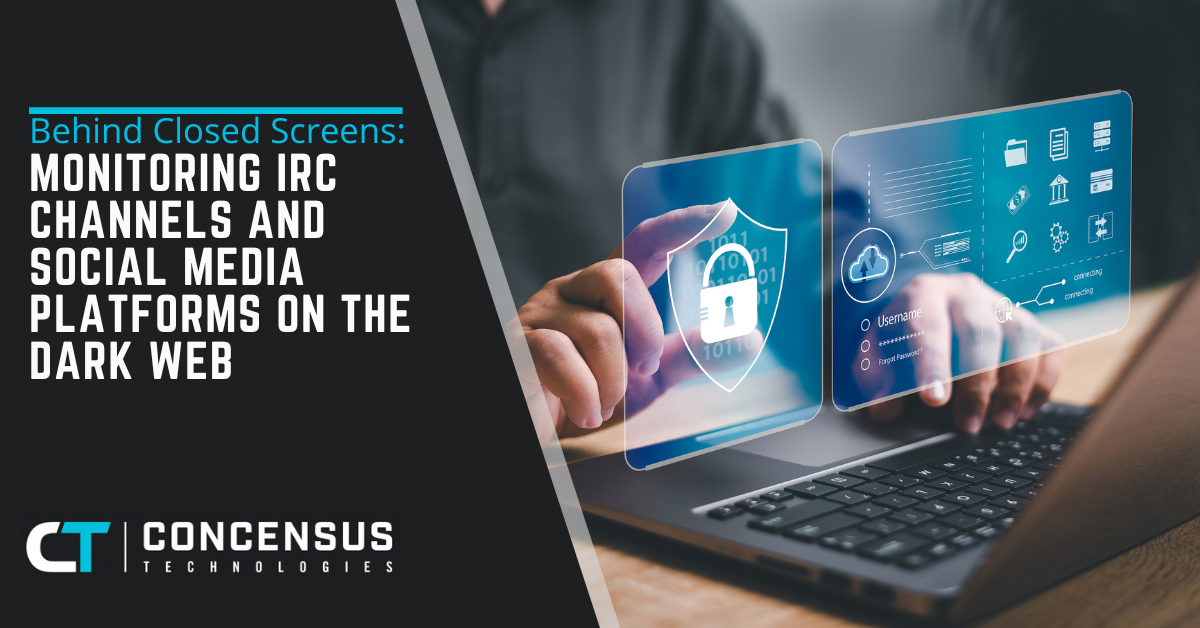
Behind Closed Screens: Monitoring IRC Channels and Social Media Platforms on the Dark Web
| September 8, 2023The digital landscape continues to evolve, with the darker corners of the internet captivating both fascination and concern. As technology advances, so do the avenues for communication, leading to the rise of platforms like the Dark Web.
This hidden realm of the internet harbors a plethora of secretive activities, and one aspect that has gained significant attention is the use of Internet Relay Chat (IRC) channels and social media platforms within the dark web. In this article, we will delve into the intricacies of monitoring these digital spaces, shedding light on the challenges and methods involved.
Unveiling the Dark Web: A Brief Overview
The Dark Web, a part of the Deep Web, is not indexed by traditional search engines and requires specialized software, such as Tor, to access. While it is home to a variety of legitimate activities, its infamous reputation is largely due to the presence of illicit markets, cybercriminal forums, and various other illegal activities. The anonymity and privacy offered by the Dark Web make it an attractive platform for those who wish to engage in activities away from prying eyes.
Internet Relay Chat (IRC) Channels: The Hidden Chat Rooms
One of the key elements of communication within the Dark Web is the use of Internet Relay Chat (IRC) channels. These are virtual spaces where users can engage in real-time text-based conversations. Unlike the surface web, where most communication is visible and traceable, IRC channels on the Dark Web provide a level of anonymity that fosters candid discussions about a range of topics, from hacking and cybercrime to political activism.
Social Media Platforms on the Dark Web: Anonymity and Interaction
Social media platforms have become an integral part of our lives, and this phenomenon extends even to the Dark Web. However, the platforms here function very differently. While anonymity remains a cornerstone, the emphasis is on privacy and restricted access. These platforms facilitate the exchange of information, the sharing of ideas, and the coordination of activities in a manner that conceals the participants’ identities.
The Challenges of Monitoring the Unseen
Monitoring the Dark Web poses unique challenges due to its hidden nature and the technical intricacies involved. While maintaining ethics and privacy is crucial, law enforcement agencies and cybersecurity professionals face an uphill battle in identifying and combating criminal activities that thrive in these digital spaces.
Anonymity and Encryption: The Double-Edged Sword
Anonymity and encryption, while valuable for user privacy, complicate the process of monitoring. Tracking individuals engaged in illegal activities becomes challenging, as they exploit these features to mask their identities and communications. Decrypting and tracing messages exchanged on IRC channels and social media platforms requires specialized tools and expertise.
Evolving Technologies: Staying Ahead of the Game
Cybercriminals are quick to adapt to new technologies, making it imperative for cybersecurity professionals to stay ahead of the curve. Developing advanced techniques to monitor and track conversations without compromising the anonymity of legitimate users is an ongoing challenge. This requires continuous research, innovation, and collaboration between law enforcement agencies, cybersecurity firms, and experts in the field.
Legal and Ethical Considerations: Walking a Fine Line
Monitoring the Dark Web comes with legal and ethical considerations. While the intention is to curb illegal activities, respecting user privacy and rights is essential. Striking a balance between surveillance and individual freedoms is a complex task that requires transparent policies and strict adherence to legal frameworks.
The Tools and Strategies of Dark Web Monitoring
Effectively monitoring IRC channels and social media platforms on the Dark Web demands a multi-faceted approach. It involves a combination of technology, human expertise, and collaboration among various stakeholders.
Deep Web Crawlers: Navigating the Unseen
Deep web crawlers play a pivotal role in indexing and collecting data from hidden web sources. These tools help identify IRC channels and social media platforms within the Dark Web, allowing experts to gain insights into trends, activities, and emerging threats.
Natural Language Processing (NLP): Decoding Conversations
The use of NLP algorithms assists in decoding and understanding text-based conversations. This technology enables experts to identify keywords, sentiments, and contextual information within IRC discussions and social media posts, aiding in the early detection of potential threats.
Collaboration and Information Sharing: Uniting Forces
Dark web monitoring cannot be carried out in isolation. Collaborative efforts involving law enforcement agencies, cybersecurity firms, and technology companies are crucial. Sharing information, threat intelligence, and best practices strengthens the collective ability to combat cybercrime effectively.
Peering into the Shadows of the Dark Web
In the complex world of the Dark Web, monitoring IRC channels and social media platforms is an intricate dance between privacy and security. Striking the right balance requires technological prowess, legal acumen, and ethical considerations. As we delve into these unseen realms, we continue to unravel the mysteries that lie behind closed screens.
If you are interested in learning more about our efforts to monitor and secure the digital landscape, feel free to contact us. At Concensus Technologies, we are committed to making the digital world a safer place for all.

